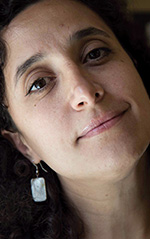Welcoming Refugees: School Campuses as Sites for Resettlement and Integration
The founder of Every Campus A Refuge describes efforts at colleges and universities nationwide to ensure refugees feel welcomed.
BY DIYA ABDO

istock.com/bspollard

Jada Ruiz, a Russell Sage College student, designed a children’s coloring book, titled “I Belong in Albany,” to help children learn the English alphabet and iconic places in Albany, New York.
Diya Abdo
More than 110 million individuals are displaced in the world right now, according to the U.N. Refugee Agency (UNHCR). That number grows every single day. While the U.S. is a world leader in resettlement, less than 1 percent of refugees globally will ever achieve resettlement.
A June 2023 study by American Immigration Council shows that refugees contributed more than $25 billion in taxes and had a spending power of more than $68.6 billion in 2019, and “similar to other immigrant populations, refugees are more likely to start businesses than native-born Americans.” That same study shows that in 2019, entrepreneurs made up 13 percent of the working-age refugee population, compared to 11.7 percent of native-born Americans.
Given the global need for an increase in resettlement and that local communities can be transformed by the diversity, knowledge, skills, and contributions that newcomers often bring, how can we both expand resettlement and invest in refugees’ inclusion and belonging to ensure they feel welcomed and want to stay when they arrive in the U.S.?
To answer these questions, I will describe my own efforts on a college campus and how our work dovetails with the State Department’s new Welcome Corps initiative.
Every Campus A Refuge Program
In 2015, as a professor of English at Guilford College in Greensboro, North Carolina, I was teaching students how to read and discuss poetry and prose. But when Syrian Aylan Kurdi drowned and his little body was found on the shore of a resort town in Türkiye that September, what I was trying to do in the classroom felt, suddenly, quite futile. What happens to human beings who are forced to leave in search of safety and security has always been personal to me, the daughter of Palestinian refugees, and certainly in a vocational and professional sense—it was there in the literature that I taught, the events I held on campus, and the student clubs I advised.
That summer, in reaction to the situation of many Syrians both in their home country and on their desperate journey to escape it, Pope Francis called on every parish in Europe to host a refugee family. I saw in his call an invocation to all small communities around the world to engage in radical hospitality, including U.S. colleges and universities. It was then I decided to found Every Campus A Refuge (ECAR).
ECAR, now a 501(c)(3), started as an initiative at Guilford College, a small, private liberal arts Quaker institution in North Carolina. We began by opening up our college resources, hosting refugee arrivals to Greensboro on our campus grounds and supporting their resettlement and integration in our midsize city. We provided free housing and utilities and access to college amenities, facilities, and resources, not least of which was community support. A dedicated cohort of student, faculty, and staff volunteers walked alongside our newest neighbors in their efforts to make a home for themselves in their country of resettlement.
We modeled ourselves on the Pope’s inspiration, realizing that like a parish, a small city, we had all the resources needed to support a newly arriving family (a campus-owned house, a cafeteria, a clinic, a library, a gym, even a farm). And we leveraged it all when we hosted refugees—including our musical instruments for a singer-songwriter, our international student club’s soccer pickup games for one family’s teenage son who loved playing the sport, and our art department’s supplies and studio and then a gallery for a calligraphist (hosted along with his wife and three sons) who created artwork and then exhibited it on campus.
Under [State’s] Welcome Corps, ordinary Americans can now privately and directly sponsor refugees.
Since our first hosted guest, Cheps, arrived on a snowy day in January 2016, we’ve hosted nearly 90 refugees on Guilford’s campus—families as large as 11 and single people alike from Sudan, Uganda, Rwanda, Burundi, the Democratic Republic of the Congo, Central African Republic, Syria, Afghanistan, Iraq, Venezuela, and Colombia. And inspired by the Pope, we called on other universities and colleges to do the same.
Years ago, when we first started ECAR at Guilford College, I quickly realized that my students were learning a lot by working alongside, and with, the refugee families we were hosting on our campus. It made perfect sense to institutionalize this learning by developing curricular and co-curricular programming that allowed students to do this work in ways that officially and formally supported their learning; so we started a minor (Forced Migration and Resettlement Studies) where students could earn credit in return for their work.
Through a recent study, published in the journal Metropolitan Universities, my colleagues and I found that students who participated in ECAR and took the minor felt “a positive impact on their career development,” “gained a working understanding … of the global refugee crisis” and its impact on “specific individuals and families over the long term,” and “developed a long-term vision for transforming the social role of postsecondary educational institutions.”
The State Department’s Welcome Corps Program
In January 2023, something remarkable happened. The U.S. Department of State launched Welcome Corps, charting another path in welcoming refugees under the U.S. Refugee Admissions Program (USRAP). Until Welcome Corps, refugee resettlement and integration had happened through the U.S. resettlement agencies, nonprofit organizations that welcome and support refugees professionally. Under Welcome Corps, ordinary Americans can now privately and directly sponsor refugees, geographically broadening the scope of this work and grounding refugee support in community-based efforts—a crucial development in creating opportunities for direct community engagement with refugees to demystify and humanize a frequently mystified and dehumanized population.
In July 2023, the Welcome Corps went a step further and announced the launch of Welcome Corps on Campus, a new official education sponsorship program. This campus expansion to Welcome Corps allows individuals associated with colleges and universities across the country to sponsor refugee students approved for resettlement in the United States while pursuing their higher education. According to the UNHCR, refugee access to higher education is a devastating 6 percent compared to the global average of 41 percent. As part of a consortium led by the Community Sponsorship Hub, ECAR the 501(c)(3) will be providing technical assistance, training, resources, and ongoing support to university and college sponsor groups as they support the academic success as well as the resettlement and integration of sponsored refugee students.

Hosted refugee Blaise Pascal performs on Guilford College’s campus.
Autumn Hollifield Photography
The Crucial Role of Diplomats and Educators Alike

Ali Sadiq Jaafar Al-Khasrachi used the art supplies at Guilford College to practice his calligraphy and artwork.
Diya Abdo
Members of the foreign affairs communities, local and foreign governments, and academia have a crucial role to play in advancing deeper engagement with refugee issues at higher education institutions (in the U.S. and globally). They can reach out to their alma maters and other universities and colleges they are connected with about ECAR and encourage starting a chapter. They can also volunteer with existing ECAR efforts to take on some resettlement tasks. For example, in Stillwater, a local retired CIA officer was incredibly helpful in Oklahoma State University’s efforts, using her organizational skills and drive to make sure every Afghan family hosted by OSU had sufficient food when they moved to town.
Diplomats in residence at universities and colleges could include ECAR-related efforts in their portfolios. During speaking tours, they could raise awareness in their speeches at higher education institutions about the refugee crisis and the ways in which universities and colleges partner with ECAR. If in a position to do so, they can also consider incentivizing higher education participation in ECAR and similar programming through grant funding, research opportunities, and educational programming.
Consider leveraging your own important networks and connections to impress upon higher education decision-makers in the U.S. and abroad the importance of this work. We all have an important part to play in transforming how we do higher education and how we do refugee resettlement, and how these two spheres can be innovatively and irrevocably linked.
The Value-Add
In my conversations with the leaders at resettlement campuses across the country, I was struck by the expansive value-add of the work. One campus leader described its effect as “collateral benefit”: supporting the Afghan women hosted on their campus and paying attention to their dietary and cultural needs fostered a change in attentiveness and response to all students’ needs, especially international students.
For many resettlement campuses, this work aligns not only with efforts to internationalize university programming and partnerships but also allows participating students to hone their intercultural skills, empathy, and compassion—a kind of “study abroad” at home. And with study abroad so expensive and inaccessible to students with jobs and families, says Jennifer N. Fish, professor and ECAR leader at Old Dominion University in Virginia, this is a truly “international immersion” experience that is “expansive” and meaningful while being suitable for students who cannot do something similar off-site due to a variety of limitations (transportation, etc.). For students preparing to work with diverse populations in their professions—as schoolteachers, nurses, and social workers—this kind of engagement is practical, experiential, and place-based.
Perhaps no better example illustrates the intersectional power of this work than one student’s project at Russell Sage College. In working with the families supported by her ECAR chapter, Jada Ruiz, an arts major at this small, private liberal arts institution in upstate New York, found that the children needed a little boost in their English language learning. Marshaling her graphic design skills, Jada created an English alphabet coloring book about Albany: “I Belong in Albany.” It not only teaches the children the English letters but also connects every letter with Albany (e.g., its special buildings, icons, modes of transportation), allowing the children to better understand their new home—where they belong.

Hosted refugees, students, faculty, staff, and community members of Every Campus A Refuge chapters at the ECAR 2022 Gathering.
Autumn Hollifield Photography
ECAR Grows
For Washington State University’s Associate Vice President for International Programs Paul Whitney, having WSU join Every Campus A Refuge was a way to support Afghan allies and stemmed from his belief in the power of higher education and its impact in the world. It was the same for Associate Provost and Dean of Oklahoma State University’s Global Studies Program Randy Kluver, who reminds us that, especially for public and land-grant institutions, the “university is all about the prosperity of [their] community.” Supporting newcomers to one’s community is “part of helping this community prosper”; indeed, it is “an investment” in that community. Over the last year, both WSU and OSU have hosted a total of 80 Afghan evacuees on their campus grounds and are supporting them in their resettlement.
They represent what I believe is a natural evolution for higher education, developing “resettlement campuses”—higher education institutions that leverage their material and human resources to support refugee resettlement and integration while transforming the educational experiences of their students.
Resettlement campuses are growing around the country in response to several realities and needs. After years of decimation to the refugee resettlement program—funding decrease, attrition of agencies and staff, significant drops in refugee admission numbers, and undermining of resettlement infrastructure and support—we found ourselves face to face with nearly 80,000 Afghan evacuees who needed the kind of support we were no longer in a place to quickly and nimbly provide. But higher education institutions also found themselves facing other issues, including continued disengagement from students during and after the pandemic, inaccessibility of international and global programming (e.g., study abroad), and lack of relevance and attention to student needs.
Imagining the Possibilities
Imagine the possibilities for our alma maters, for the universities, colleges, and community colleges in our American towns and cities, where our family members study, where we teach and work, and on whose boards we sit.
And now imagine the possibilities for the world. There are nearly 25,000 institutions of higher education around the globe. And though they might be vastly different in significant ways, they are fundamentally the same in others: They are all communities, bound together by shared goals and values, occupying shared spaces, designed to support humans succeed.
With the current trends in forced migration and the threat of large-scale displacement due to climate disasters, any one of us, or our children, or their children, can become displaced. By creating resettlement campuses, we are planting and tending a garden that will feed future generations. We are building sustainable ecosystems that can support us in our darkest hour.
When sharing or linking to FSJ articles online, which we welcome and encourage, please be sure to cite the magazine (The Foreign Service Journal) and the month and year of publication. Please check the permissions page for further details.
Read More...
- “How Refugee Resettlement in the United States Actually Works” by Carol Colloton, The Foreign Service Journal, April 2016
- “Revisioning the University Campus” by Diya Abdo, TedxWakeForestU, February 2020
- “Seeking Justice, Seeking Hope: Refugee Resettlement Campuses and Transformative Pedagogy in Higher Education” by Sonalini Sapra, Christian Matheis, and Diya Abdo, Metropolitan Universities, March 2023





